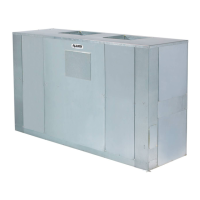Page 96
C11 DIAGRAM
Electromechanical Thermostat
with Night Setback Thermostat
and without Economizer
8-C11 SECTION (electromechanical thermostat with night relay kit)
Optional night (setback relay) kit allows GCS16 units without economizer (REMD16 or
EMDH16) to automatically setback the thermostat to reduce energy consumption during times
when the building is not occupied. The night kit achieves this by electrically disconnecting ther
mostat S1 and connecting a night thermostat during periods when the building is not occupied.
The night thermostat can then be adjusted with a lower setpoint as needed for unoccupied
heating.
NOTE - In order to understand how these optional controls affect the operation of the GCS16,
you must first understand how all GCS16 components work. Refer to the operation se
quence for basic unit operation.
WARNING - CONNECT ONLY RELAY KITS DESIGNED FOR THIS CONTROL SYSTEM.
RELAY KITS DESIGNED FOR OTHER CONTROL SYSTEMS ARE NOT COMPATIBLE
AND CONTROL DAMAGE OR FAILURE WILL RESULT. FOR EXAMPLE, ON UNITS US
ING AN ELECTROMECHANICAL THERMOSTAT WITHOUT AN ECONOMIZER, A
WARM-UP KIT MUST NOT BE CONNECTED. ONLY THE OPTIONAL NIGHT KIT CAN
BE USED.
WARNING - BE CAREFUL TO CONNECT RELAY KITS TO THE PROPER JACK AND
PLUG IN THE GCS16 BLOWER COMPARTMENT. REFER TO WIRING DIAGRAM. IM
PROPER CONNECTION WILL CAUSE CONTROL FAILURE.
NOTE -
1-The night kit accessory requires the use of optional time clock CMC3-1/ and optional night
thermostat.
2-The time clock accessory requires the use of field wired night kit relay K11.
No wiring is required for installing the kit. Jumper plug P3 is removed from the unit and dis
carded. Night kit harness plug P4 connects directly into jack J3 in the unit blower compartment
(see figure 93).
Night Setback:
NOTE-This operation sequence emphasizes nightkit operation. Unit diagram has been
omitted.
1- Time clock CMC3-1 contacts are open during normal operation of the unit when the building is
occupied. All cooling and heating stages function normally.
2- When clock contacts switch closed (when the building is not occupied) relay K11 is energized.
3- When relay K11 is energized, contacts K11-1 open disconnecting power to thermostat S1.
Thermostat S1 remains disconnected until clock contacts open (usually 1 hour before the
building is to be occupied). During the time thermostat S1 is disconnected, night thermostat
S12, which has been set at a lower setpoint than S1, controls operation of the unit.
During unoccupied periods, K11-1 opens and S1 is disabled. When S12 closes, power is sup
plied to S1 and the unit operates normally. When S12's setpoint opens, S1 is disabled and unit
operation stops.
4- The blower operates as normal, controlled by heating demand when S12 is closed.
5- Shortly before the building is to be occupied, time clock CMC3-1 contacts open and relay K11
is de-energized. Contacts K11-1 then close and power is restored to thermostat S1.

